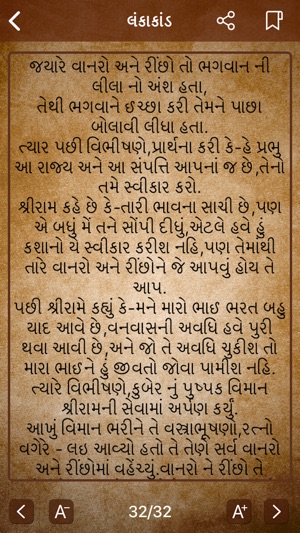Kerala - The Malayalam language Adhyatma Ramayanam Kilipattu written by Thunchaththu Ezhuthachan in the 16th century. Gujarat - The Tulsi-Krta Ramayana is a Gujarati adaptation of Tulsidas' Ramcharitamanas in 17th century, by the poet Premanand Swami. Urdu version called the Pothi Ramayana was written in 17th century. Amrut Ramayan Gujarati Book Written by Moraribapu Buy Online with Free shipping and Cash On delivery with Best Discount. Language: Gujarati Free Shipping on order. રાજપુતની પ્રતિજ્ઞાા l Rajput ni partigna I ishardan gadhvi gujarati lok katha l ગુજરાતી લોક કથા l - Duration: 19:51. Gujarati-Ramayan-Rahasya-Book-Read Online OR Download. Katha in Gujarati for Download Katha-Audio-click here New Video -Mumbai Katha-1972-on U tube By Mukeshbhai.

Shambuka (IAST: śambūka) is an interpolation in Valmiki Ramayana.[1][2] According to a version Shambuka, a shudra ascetic, was slain by Rama for attempting to perform penance in violation of dharma, the bad karma resulting from which caused the death of a Brahmin's son.[3]
Rama's killing of Shambuka or even the existence of the character Shambuka is highly disputed. The story is treated as a later interpolation to Valmiki's Ramayana, being created at a later period in opposition to Brahmins.[1][4][5]
Story[edit]
When Rama was ruling Ayodhya, a Brahmin approached the court and told everyone that his young son has died due to the misrule of Rama. Rama immediately called a meeting with all his ministers and enquired about the cause of this. Narada, one of the sages, told him that this has happened due to violation of a rule of penance. Narada informed him that someone from the Shudra varna, who are not allowed to perform penance in this Yuga, is performing a penance due to which the child has died. So Rama went in search of that person and found the place where Shambuka was performing penance. After confirming that Shambuka is indeed a Shudra, Rama killed him. Gods praised Rama for this act of his and congratulated him for protecting their interests and for not allowing Shudra to attain heaven. Brahmin's son returned back to life after it.[1][6]
Reception[edit]
Authors such as Rabindranath Tagore, Mahatma Gandhi treat the character of Shambukha as interpolation.[7][8] The PushtimargVaishnavite tradition points out that the Ramayana refers to other Shudras, such as Shabari, who lived in the forest. Shambuka therefore deliberately violated dharma in order to get Rama's attention, and attained salvation when he was beheaded.[9] The celebrated Kannada poet Kuvempu, in his play Shudra Tapasvi shows Rama as having to both carry out his duty by punishing Shambuka, and simultaneously protect Shambuka, as a pious and devout sage, from persecution, and thereby turns the story into a critique of Brahminical attitudes and a defense of Rama.[10]
Ramayan In Gujarati Language Translation
In his seminal work Annihilation of Caste, Ambedkar points out the story of Shambuka while criticizing Chaturvarnya. He argues that not only it is impossible to accurately classify people into four definite classes but that the system of Chaturvarnya faces the problem of the transgressor. He further explains that unless the transgressor is punished, men will not keep to their respective classes i.e. the whole system will collapse. In Ramayana, according to Ambedkar, Rama ensured that transgression did not happen in his kingdom by killing Shambuka.[11][12][13]


Notes[edit]
Ramayan In Gujarati Language
- ^ abcPaula Richman (2008). Ramayana Stories in Modern South India: An Anthology. Indiana University Press. p. 111. ISBN978-0-253-21953-4.
- ^Indian Literature, Issues 213-218. Sahitya Akademi. p. 163.
- ^Government of Maharashtra, Nasik District Gazeteer: History - Ancient Period'Archived copy'. Archived from the original on 7 November 2006. Retrieved 1 October 2006.CS1 maint: archived copy as title (link) (text credited to Mahamahopadhyaya Dr. V. V. Mirashi)
- ^An Introduction to Eastern Ways of Thinking. Concept Publishing Company. p. 158.
By now , it can be confirmly said the ' Uttarkand ' of Ramayana is an interpolation of quite later period
- ^Mangesh Venktesh Nadkarni. Hinduism, a Gandhian Perspective. Anne Books. p. 92.
- ^Hari Prasad Shastri (1957). The Ramayana of Valmiki. Shanti Sadan. pp. 1579–1584. ISBN978-0-8542-4048-7.
- ^Gangeya Mukherji. An Alternative Idea of India: Tagore and Vivekananda. Taylor & Francis. p. 83. ISBN9781000083774.
- ^D. K. Misra, Shambhu Lal Doshi, C. M. Jain (1972). Gandhi and Social Order. Research Publications in Social Sciences. p. 14.
Mahatma Gandhi , on the other hand, has regarded this entire story as an interpolation
CS1 maint: multiple names: authors list (link) - ^Motiramji Sastri, Ramayan (in Gujarati) (Ahmedabad, 1961).
- ^'M. Raghava, 'The king and the protector of the devout' The Hindu (26 October 2004).
- ^B.R. Ambedkar (2020). Ambedkar's India. Sristhi Publishers & Distributors. p. 47. ISBN9789387022898.
- ^Aishwary Kumar (2015). Radical Equality: Ambedkar, Gandhi, and the Risk of Democracy. Stanford University Press. p. 292. ISBN9780804794268.
- ^Kurukundi Raghavendra Rao (1993). Babasaheb Ambedkar. Sahitya Akademi. p. 25. ISBN9788172011529.

